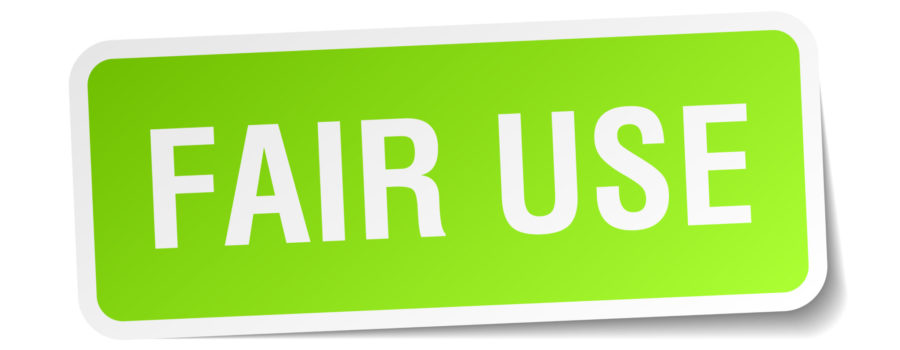There are a lot of myths and misconceptions when it comes to copyrights and the fair use defense. In this post we will clarify some of your doubts.
Through these posts, we discussed specific aspects of copyrights, such as works made for hire and the first sale doctrine.
The fair use defense of copyright is the subject of many federal court disputes. Some of those disputes lead up to court opinions that set precedent. It is through precedent, that much of this topic is applied to today’s reality.
The law.
Copyright law grants the author or creator of a work a set of exclusive rights. These rights are set forth at 17 U.S.C. sec. 106 y 106A. At the same time, the law also sets limits on these exclusive rights. These limitations are known as fair use. They are set forth at 17 U.S.C. sec. 107.
In essence, when a work is used for purposes of (i) criticism, (ii) comment, (iii) news reporting, (iv) teaching, (v) scholarship or (vi) research, it will be considered as fair use, and will not be an infringement of copyright. However, as in all, there are exceptions and limitations. Even if the proposed use falls within one of these purposes, it still has to go through the fair use test.
The fair use test.
In copyright law, fair use is not a right, it is a defense. As a defense, it has to overcome legal challenges. This challenge is known as the fair use test. The fair use test is composed of four factors. These factors are set forth at 17 U.S.C. sec. 107 and discussed in multiple federal court opinions. In essence, this test serves to protect and preserve the commercial integrity and viability of the original work for as long as it enjoys copyright protection. The test looks at:
- The purpose and character of the use: The reasoning behind this is to know why the user wants to use the work, and what does the user get out of using the work. For example: Will commercial benefit be derived from the use? Is it for educational purposes?
- The nature of the work: The purpose of this is to know a bit more about the original work being used and gauge it within the creativity spectrum of the realm of copyrights. Is it a highly creative work? Is it technical in nature, therefore less creative?
- The amount and substantiality of the portion used: Contrary to popular belief, there is no magic number or secret formula to calculate this with. How much of the original work is to be used? Is it the heart and soul? How much is too much? The answer will always be dependent on the original work.
- The effect of the use upon the potential market for or value of the copyrighted work: At the end of the day, copyright law is about protecting and securing the copyright’s owner right to have control over the use of the work. With this control, comes the right to derive economic benefit from the work. This factor of the fair use test serves to identify how someone else’s use of the work might impact the copyright owner’s exclusive right to commercially exploit the work.
Each one of these four factors of the fair use test consider the original work and the intended use from a specific angle. Not one of these four factors is determinative of whether the use is fair or not. It is the answers to all four, taken as a whole, which will be determinative.
In some instances this will be a complicated matter and true controversy. But for many, common sense should guide the way.
In real life.
Fair use issues manifest themselves everyday in different scenarios. Let’s use an educational setting. A teacher may make multiple copies of a document to handout to the students in the class. That same teacher may use an illustrative image in the classroom for that day’s class. That same teacher may even show a video or audio clip in the classroom to complement that day’s lesson. All three of these uses are fair use. However, if the teacher was to upload the handout copy, the illustrative image or the video/audio clip unto an educational platform, the use on the educational platform might not be considered fair use, and an analysis using the four factors of the fair use test would be necessary. In fact, many universities have found themselves in legal disputes over content uploaded unto the school’s educational platform by faculty members. Why? That’s matter for another post.
Let’s move to a different setting. The entertainment industry sees its fair share of fair use controversies. A television commercial incorporates a sound bite of a popular song without obtaining a licence to use the song. Is is fair use? Let’s see.
- The purpose and character of the use: The use of the song is for a television commercial. The purpose of commercials is to promote sales and generate income.
- The nature of the work: Songs are highly creative works.
- The amount and substantiality of the portion used: Use of a popular song, no matter how big or small the sound bite, is to peak interest. Most likely the commercial incorporates the most popular segment or section of the song.
- The effect of the use upon the potential market for or value of the copyrighted work: Subject to the content of the television commercial, it may have an impact on the sales of the song. This impact may be a direct or indirect one, it may be direct sales or streams. Song lovers may be pushed away due to the nature or content of the commercial.
Upon review of the four factor fair use test, it is very likely that the use of the sound bite in the television commercial is not fair use. Therefore the fair use defense would not prosper. And the use be copyright infringement. Costing the television commercial producer and company a hefty sum. How could this have been avoided, by obtaining a licence prior to airing the commercial or creating their own sound bite, among other options.
Stay tuned for upcoming posts.
Author: Patricia Ramírez Gelpí, J.D., LL.M
Image: Aquir/Shutterstock.com





